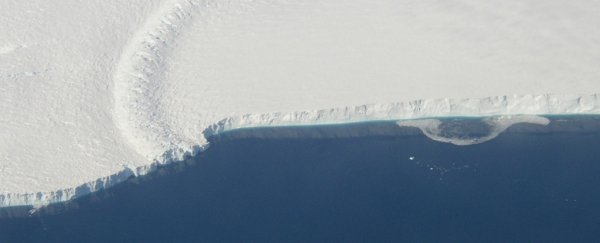The days of Antarctica's Pine Island glacier are numbered, but no one really knows what that number is. New models could help shed some much-needed light on the matter.
In the past four decades, this slow-moving monstrosity of ice has contributed more to sea level rise than any other glacier on Earth, and recently, scientists have noticed signs it might be accelerating and thinning unusually fast.
Predicting where and how a glacier of this scale could recede is notoriously difficult. While they might look like simple, solid slabs of ice from above, these structures actually hide extremely complicated and dynamic flow systems that we still don't know enough about.
With the dawn of the climate crisis, some models predict the melting Pine Island glacier will reach its grounding line - where the glacier first meets the ocean - and float within a century. Other scenarios indicate a sixfold increase in mass ice loss and a 40 kilometre (25 mile) migration of the grounding line in less than two decades.
But while the shrinking of Pine Island glacier shows no signs of slowing, new data suggests it isn't speeding up either.
Using high-resolution satellite observations from the European Space Agency (ESA), researchers at the University of Bristol have tracked the ebbs and flows of Antarctica's largest glacier, and their results are quite the surprise.
In fact, it was just the opposite of what scientists were expecting. Unlike observations in 2010, the findings today show the glacier is thinning the fastest along the slow-flow margins, while the fast-flowing centre has slowed down by five-fold since 2007.
Without some unforeseen change in the glacier's interaction with the ocean, the authors argue these measurements are inconsistent with a fast 'ungrounding' of the glacier and the rapid losses of ice mass that would follow.
"Instead," they write, "our results support model simulations that imply only modest changes in grounding-line location over that timescale."
 (University of Bristol)
(University of Bristol)
In short, the data suggest the Pine Island glacier is going to lose mass, but not any faster than it already is. Under present-day thinning rates, the glacier has retreated by 20 kilometres in 50 years, and this, according to the authors, is 'negligible' compared to more extreme estimates.
Nevertheless, physicist Jonathan Bamber from the University of Bristol warns against getting too excited.
"This could seem like a 'good news story'," he says, "but it's important to remember that we still expect this glacier to continue to lose mass in the future and for that trend to increase over time, just not quite as fast as some model simulations suggested."
"It's really important to understand why the models are producing different behaviour in the future and to get a better handle on how the glacier will evolve with the benefit of these new observations."
The findings were published in Nature Geoscience.
